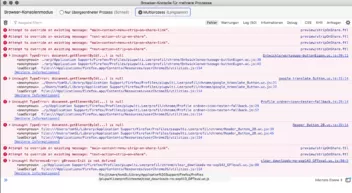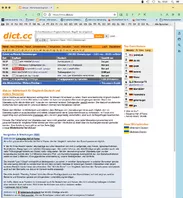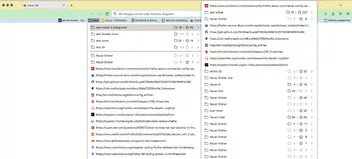Bislang v140.0rc1
a\ Kein Konflikt mit Unified Extensions Button!
.....Sie sind nach Aris-t2 die zweite Person, die die vertikale Symbolleiste erstellen konnte!
Das ist mal eine hilfreiche Rückmeldung, vielen Dank! ![]()
V.a. die Buttons waren mir wichtig, auch hier schon kurz angesprochen.
Wie erwähnt, das Script hier ist ein ganz grober Test; in dieser Form funktioniert es nur rechts, kann aber recht einfach mit weiteren Optionen versehen werden; viele kosmetische Anpassungen wären auch noch vorzunehmen, etc..
Es ist auch nicht von mir usprünglich, und basiert auf diesem Ansatz.
Noch ein grober Test mit Positionierungsoptionen:
JavaScript
//Toggle newtoolbar 8 test
(function() {
if (location.href !== 'chrome://browser/content/browser.xhtml')
return;
// Eigenes Icon
let ProfilePath = PathUtils.toFileURI(PathUtils.join(PathUtils.profileDir, 'chrome', 'icons'));
let icon1 = 'newtoolbar.png';
let ImagePath = ProfilePath + icon1;
let new_tb_loc = 1; // Position: 0 Rechts 1 Links 2 Bottom
if (Services.prefs.getBoolPref('svg.context-properties.content.enabled') == false) {
Services.prefs.setBoolPref('svg.context-properties.content.enabled', true );
}
let toolbox_new = document.createXULElement('toolbox');
toolbox_new.setAttribute('id','toolbox_new');
const element = document.getElementById("navigator-toolbox");
const rect = element.getBoundingClientRect();
let ntb = document.createXULElement('toolbar');
ntb.id = 'newtoolbar';
ntb.setAttribute('customizable', true);
ntb.setAttribute("class","toolbar-primary chromeclass-toolbar browser-toolbar customization-target");
ntb.setAttribute('mode', 'icons');
ntb.setAttribute('context', 'toolbar-context-menu');
toolbox_new.appendChild(ntb);
//Geht
document.getElementById('navigator-toolbox').appendChild(toolbox_new);
//Geht
//document.getElementById('nav-bar').appendChild(toolbox_new);
//geht height #2 not dynamic ???
document.getElementById('toolbox_new').style.setProperty('--height_newbar', rect.height + 'px');
CustomizableUI.registerArea('newtoolbar', {legacy: true});
CustomizableUI.registerToolbarNode(ntb);
try {
CustomizableUI.createWidget({
id: 'NewToolbar_button',
type: 'custom',
defaultArea: CustomizableUI.AREA_NAVBAR,
onBuild: function(aDocument) {
let toolbaritem = aDocument.createXULElement('toolbarbutton');
let props = {
id: 'NewToolbar_button',
class: 'toolbarbutton-1 chromeclass-toolbar-additional',
removable: true,
label: 'Toggle New Toolbar',
tooltiptext: 'Toggle New toolbar',
};
for(let p in props)
toolbaritem.setAttribute(p, props[p]);
return toolbaritem;
}
});
} catch(e) { };
// Position
if (new_tb_loc === 1) {
toolbox_new.classList.add("left_mode");
browser.classList.add("left_mode_b");
}
if (new_tb_loc === 2) {
toolbox_new.classList.add("bottom_mode");
browser.classList.add("bottom_mode_b");
}
// button
document.getElementById('NewToolbar_button').addEventListener( "click", newTB );
function newTB(aEvent, keyEvent=false) {
if(!keyEvent && aEvent.button != 0) {
return;
}
newtoolbar.classList.toggle("off-mode");
browser.classList.toggle("off-mode_b");
}
const css =`
:root {
--ug-newbar_width: 42px;
--ug-newbar_bg_color: lightblue;
}
#NewToolbar_button .toolbarbutton-icon {
list-style-image: url("chrome://browser/skin/sidebars-right.svg") !important;
/*list-style-image: url("${ImagePath}") !important;*/
}
#navigator-toolbox {
z-index: 444 !important;
}
/*
#nav-bar {
z-index: 4 !important;
}
*/
#browser {
transition: padding 0.5s ease !important;
}
#newtoolbar .toolbarbutton-1 {
margin-block: 2px !important;
}
/*
#newtoolbar .toolbarbutton-1 image {
outline: 1px solid red !important;
}
#sidebar-box {
outline: 4px solid red !important;
outline-offset: -2px !important;
}
*/
/* Basis / Right */
#browser:not(.off-mode_b) {
padding-right: var(--ug-newbar_width) !important;
}
#toolbox_new {
position: fixed;
display: flex;
flex-direction: column;
width: var(--ug-newbar_width);
bottom: 0;
right: 0;
}
#newtoolbar {
display: flex;
flex-direction: column;
/*z-index: 4 !important;*/
width: var(--ug-newbar_width);
padding-block: 8px;
height: calc(100vh - var(--height_newbar));
background-color: var(--ug-newbar_bg_color) !important;
box-shadow: -1px 0 grey;
border-top: 1px solid grey;
transition: width 0.5s ease, margin 0.5s ease, height 0.5s ease;
}
#newtoolbar:not([customizing]).off-mode {
margin-inline: 0 calc(0px - var(--ug-newbar_width));
box-shadow: none;
}
/* Left */
#browser:not(.off-mode_b).left_mode_b {
padding-inline: var(--ug-newbar_width) 0 !important;
}
#toolbox_new.left_mode {
left: 0;
}
.left_mode #newtoolbar {
box-shadow: 1px 0 grey;
}
.left_mode #newtoolbar:not([customizing]).off-mode {
margin-inline: calc(0px - var(--ug-newbar_width)) 0;
}
/* Bottom */
#browser:not(.off-mode_b).bottom_mode_b {
padding-inline: 0 !important;
padding-bottom: var(--ug-newbar_width) !important;
}
#toolbox_new.bottom_mode {
flex-direction: row !important;
width: 100vw;
}
.bottom_mode #newtoolbar {
flex-direction: row !important;
height: var(--ug-newbar_width);
width: 100vw;
padding-block: 0;
padding-inline: 8px;
box-shadow: 0 -1px grey;
border: none;
}
.bottom_mode #newtoolbar:not([customizing]).off-mode {
margin-inline: 0;
margin-block: 0 calc(0px - var(--ug-newbar_width)) !important;
}
.bottom_mode #newtoolbar .toolbarbutton-1 {
margin-inline: 2px !important;
}
/* customizing */
#newtoolbar[customizing] {
min-width: 0 !important;
width: fit-content !important;
}
.bottom_mode #newtoolbar[customizing] {
width: 100vw !important;
}
#customization-container {
margin-inline: 0 var(--ug-newbar_width) !important;
}
#browser.left_mode_b + #customization-container {
margin-inline: var(--ug-newbar_width) 0 !important;
}
#browser.bottom_mode_b + #customization-container {
margin-inline: 0 !important;
margin-bottom: var(--ug-newbar_width) !important;
}
`;
const sss = Cc['@mozilla.org/content/style-sheet-service;1'].getService(Ci.nsIStyleSheetService);
const uri = Services.io.newURI('data:text/css,' + encodeURIComponent(css));
sss.loadAndRegisterSheet(uri, sss.AGENT_SHEET);
})();





